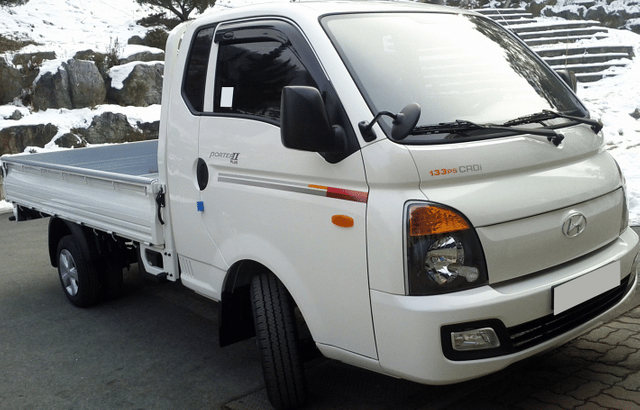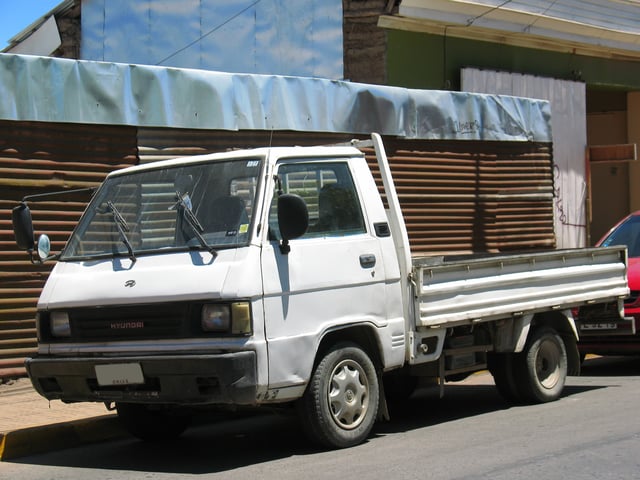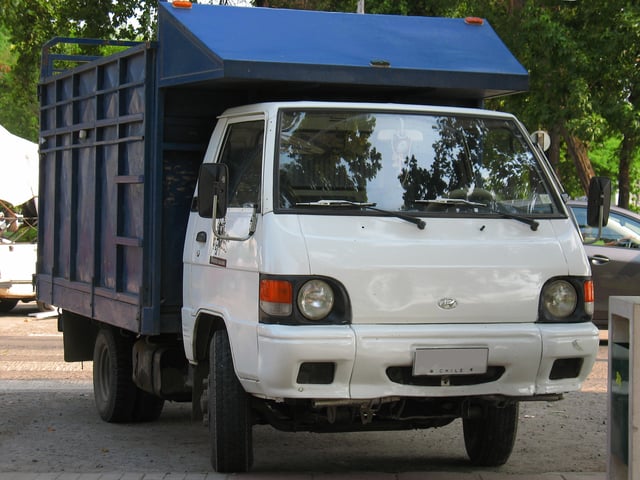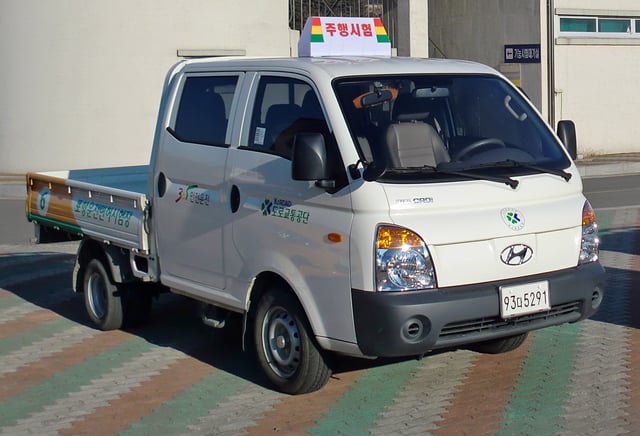Hyundai Porter

Hyundai Porter

| Hyundai Porter | |
|---|---|
 | |
| Overview | |
| Manufacturer | Hyundai |
| Also called | Hyundai H-100 JAC Shuailing X |
| Production | 1977–present |
| Model years | 1977–1981 1986–1996 1996–2004 2004–present |
| Assembly | Ulsan, South Korea, |
| Body and chassis | |
| Layout | FR layout F4 layout |
| Related | Kia Bongo |
| Hyundai Porter 2004–present | |
| Overview | |
| Manufacturer | Hyundai |
| Also called | Hyundai H-100 |
| Production | 2003–present |
| Assembly | Ulsan, South Korea Tiaret, Algeria[7] (TMC Group) 2018-present |
| Layout | FR layout |
| Powertrain | |
| Engine | 2.6L T2 I4 CRDi (diesel) 2.5L A2 I4 CRDi Turbo (diesel) |
| Transmission | 5-speed manual (T2 engine) 6-speed manual (A2 engine) |
| Dimensions | |
| Wheelbase | 2,430 mm (95.7 in) or 2,640 mm (103.9 in) |
| Length | 4,810–5,175 mm (189.4–203.7 in) |
| Width | 1,740 mm (68.5 in) |
| Height | 1,970 mm (77.6 in) |
| Curb weight | 1,620–1,794 kg (3,571–3,955 lb) |
| Hyundai Porter | |
|---|---|
 | |
| Overview | |
| Manufacturer | Hyundai |
| Also called | Hyundai H-100 JAC Shuailing X |
| Production | 1977–present |
| Model years | 1977–1981 1986–1996 1996–2004 2004–present |
| Assembly | Ulsan, South Korea, |
| Body and chassis | |
| Layout | FR layout F4 layout |
| Related | Kia Bongo |
| Hyundai Porter 2004–present | |
| Overview | |
| Manufacturer | Hyundai |
| Also called | Hyundai H-100 |
| Production | 2003–present |
| Assembly | Ulsan, South Korea Tiaret, Algeria[7] (TMC Group) 2018-present |
| Layout | FR layout |
| Powertrain | |
| Engine | 2.6L T2 I4 CRDi (diesel) 2.5L A2 I4 CRDi Turbo (diesel) |
| Transmission | 5-speed manual (T2 engine) 6-speed manual (A2 engine) |
| Dimensions | |
| Wheelbase | 2,430 mm (95.7 in) or 2,640 mm (103.9 in) |
| Length | 4,810–5,175 mm (189.4–203.7 in) |
| Width | 1,740 mm (68.5 in) |
| Height | 1,970 mm (77.6 in) |
| Curb weight | 1,620–1,794 kg (3,571–3,955 lb) |
History
First generation (1977–1981)
The first generation, launched in January 1977, was called the Hyundai HD1000 and was available in both truck and minibus (3 and 12-seater van, ambulance) versions. The truck was called the Porter. The HD1000 was discontinued in 1981.
Second generation (1986–1996)

1986-1993 Hyundai Porter
In November 1986, Hyundai revived the label with the introduction of the second generation Porter, which was now a rebadged licensed second generation Mitsubishi Delica (L300). While the third generation Delica was also built by Hyundai, it was known as the Grace and was marketed only as a van, in parallel with the Porter truck range. It was built with the following body styles: 2-door truck, 4-door truck, 3-door van and 4-door van.
Upgrade

1993–1996 Hyundai New Porter
The upgraded second generation was a facelifted version of the second generation model. Round headlights, a steering wheel from the 1991 Sonata, and the dashboard from the newer Grace, were the main differences. In The Netherlands, it was called Hyundai H150.
The 1993 Porter was available with a regular cab, an extended cab, or a double cab. The four-cylinder engine was called the Cyclone D4BX,[5] a Hyundai built version of Mitsubishi's 4D56 2.5 liter diesel four-cylinder.
Third generation (1996–2004)

Hyundai Porter
The third generation, called the New Porter that called in upgraded version of 2nd generation Porter, was launched in March 1996. It was built with the following body styles: 2-door truck, 4-door truck, 3-door van and 4-door van. In South Africa, it was known as the Hyundai Bakkie. In The Netherlands, it was called Hyundai H150. In Malaysia, it was known as Inokom AU26. In Pakistan, it entered production in 1999 and was called the Hyundai Shehzore.[6]
Fourth generation (2004–present)

Hyundai Porter, double cab
The fourth generation is called the Porter II. In South Korea, it is available as either a single-cabin, extended-cabin or a double-cabin model. The single-cab model is available with a choice of two wheelbases, 2,430 mm (95.7 in) or 2,640 mm (103.9 in); the extended-cab is limited to the longer wheelbase; and the double-cab is limited to the shorter wheelbase.[8]
There is also a choice of two engines: a T2 (D4BB) 2.6-litre inline-four, common rail diesel engine, which develops a maximum power of 79 PS (58 kW) at 4,000 rpm and a maximum torque of 17 kg⋅m (123 lb⋅ft) at 2,200 rpm; or an A2 2.5-litre I4 common rail turbo diesel engine which develops a maximum power of 130 PS (96 kW) at 3,800 rpm and a maximum torque of 26 kg⋅m (188 lb⋅ft) from 1,500–3,500 rpm.
Local names
| Country | Assembled | Make | Model | Since |
|---|---|---|---|---|
| South Korea | Ulsan | Hyundai | H-100 Porter | 1977 |
| Brazil | Anápolis | Hyundai | HR | |
| Libya | Hyundai | Dragonfly | ||
| Malaysia | Kulim | Inokom | Lorimas AU26 | |
| Mexico | Dodge | H-100 | ||
| Pakistan | Hyundai | Shehzore | 1999[1] | |
| Russia | Yes[2] | Hyundai | Porter | |
| South Africa | H100 | Hyundai | Bakkie[3] | 1997 |
| Vietnam | Ho Chi Minh City | Thaco | Frontier, K190[13] | |
| Algeria | Tiaret[14] | Hyundai | H-100 | 2018 |
Notes
See also
Mitsubishi Delica
Hyundai Grace
Kia Bongo